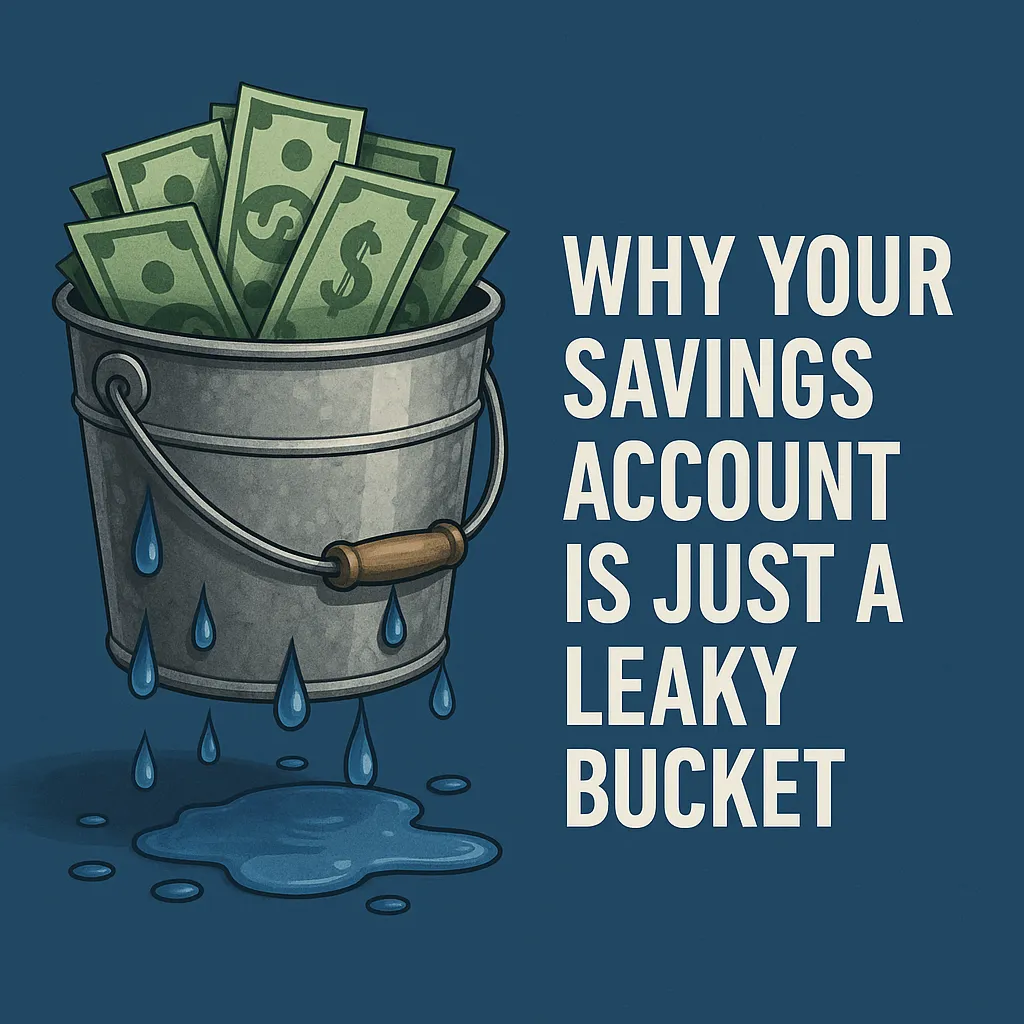
Why Your Savings Account Is Just a Leaky Bucket
Most of us grew up with the same advice: save your money in the bank. Open a savings account, let it sit, and watch it grow. That was the promise. But in today’s world, your savings account is less like a secure vault and more like a bucket riddled with tiny holes. Slowly, quietly, your money leaks away.
The Myth of “Safe” Savings
On the surface, a savings account feels safe. Your balance is stable, insured, and easy to access. But the safety is an illusion. While the numbers on your screen don’t go down, the value of those dollars does.
Inflation is the leak in the bucket. When the cost of food, housing, and energy rises every year, the money sitting in your bank loses purchasing power. You may still see “$10,000” in your account, but what that $10,000 can buy is shrinking.
Historically, the average annual inflation rate in the U.S. is about 3%. That means that over 20 years, a dollar loses nearly half its purchasing power. At today’s higher inflation rates, the leak in your bucket is even bigger.
Interest Doesn’t Plug the Holes
Banks try to cover the leak by offering interest. But let’s be honest — the patch doesn’t hold.
Savings accounts today often yield less than 1% interest, while inflation is 3–5% or more. Even so-called “high yield” savings accounts rarely keep up with real inflation. So while you might feel like you’re earning money, you’re still losing ground.
Imagine pouring water into a bucket with a hole at the bottom. Adding a trickle of interest doesn’t stop the leak. The water level still goes down.
Fiat Money Is Designed to Leak
Here’s the hard truth: the system is built this way. Fiat money (government-issued currency) is intentionally inflationary. Central banks expand the money supply, governments run deficits, and your savings pay the price.
In other words, your savings account isn’t failing because your bank is bad at patching leaks. It’s failing because the bucket itself was designed to drain. Inflation is not a bug in the fiat system — it’s the feature.
Bitcoin as the Sealed Vessel
Now contrast this with Bitcoin. Bitcoin is engineered as the opposite of a leaky bucket. Its supply is capped at 21 million coins. New coins are created at a predictable rate that halves every four years. No central bank can “print” more Bitcoin to erode your savings.
Instead of inflation, Bitcoin offers disinflation — the rate of new supply slows over time, making each unit scarcer. Holding Bitcoin is like pouring water into a vessel sealed shut. You don’t need to worry about leaks from endless money printing.
Yes, Bitcoin’s price is volatile in the short term. The waves go up and down. But over the long term, the sealed vessel effect is clear: Bitcoin preserves value while fiat money drains away.
Why This Matters for You
If you’re young, you’ve already seen housing prices, tuition, and everyday goods soar out of reach. You know the frustration of trying to save for the future while your account balance seems to shrink in real terms.
The choice is simple:
Keep using the leaky bucket, watching your effort drip away.
Or start stacking into Bitcoin, where your savings sit in a sealed, scarce, and durable vessel.
The Bottom Line
A savings account might feel secure, but it’s quietly bleeding out through the holes of inflation. Don’t mistake the still surface of the water for safety. Over time, the leaks add up, and your bucket runs dry.
Bitcoin is not a get-rich-quick scheme. It’s not magic internet points. It’s simply money without the leaks.
If you want to save for the future, stop patching a broken bucket. Pick the vessel that holds.
Shout out to BullishBTC.com – your home for learning how to seal your financial future with Bitcoin.



